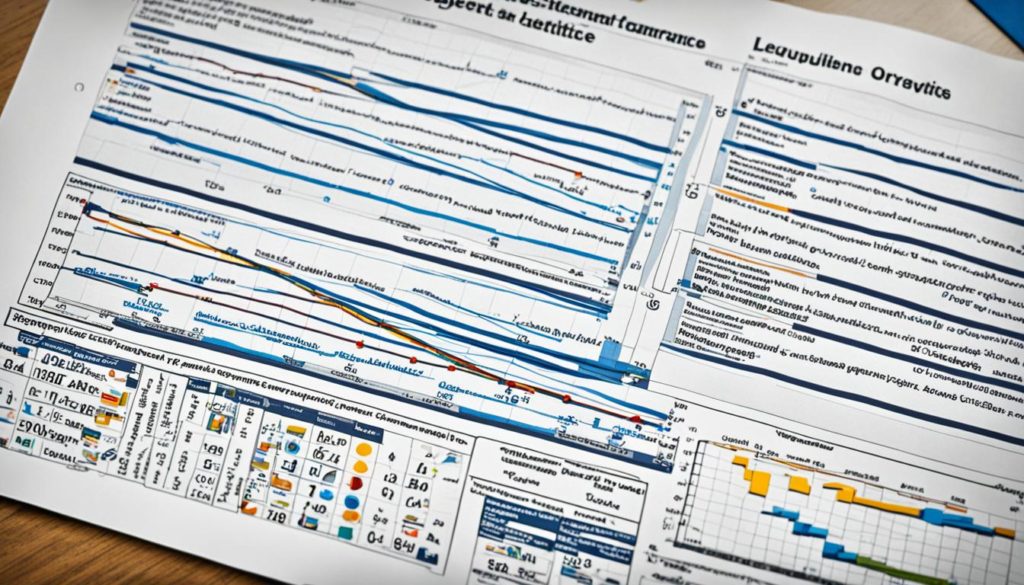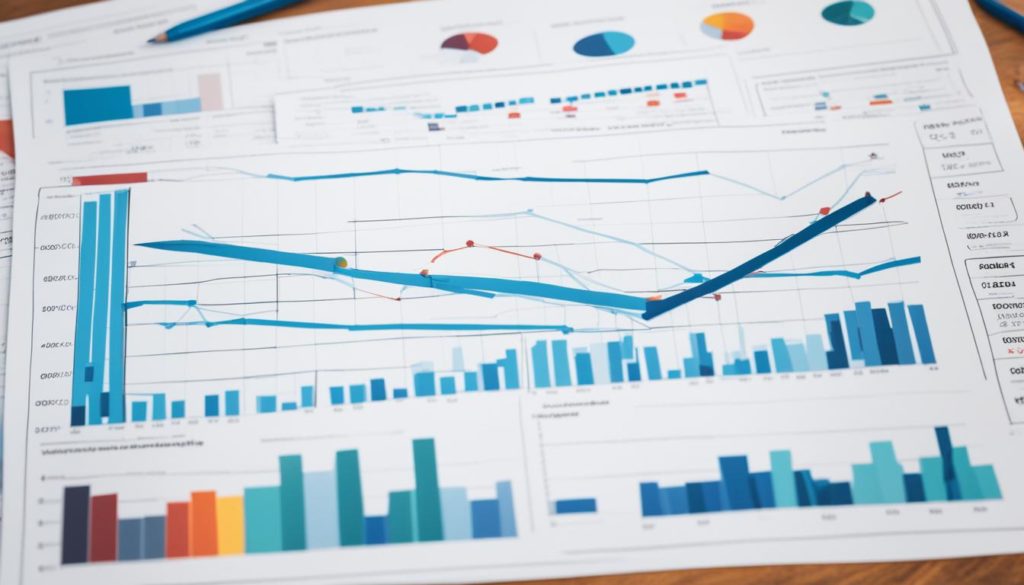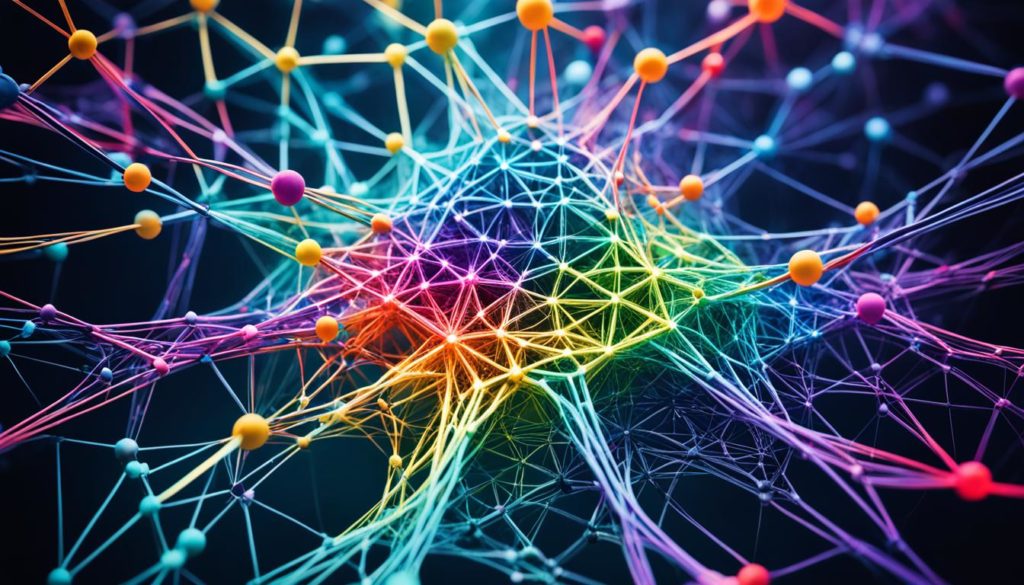
Did you know that efforts in learning analytics in education have grown a lot in the last decade? This growth shows the role of learning analytics in making education better and more helpful. Today, nearly all vendors of learning tools add some analytics to their offerings, showing its value.
In places like Boston University, combining data from systems, forums, messengers, and Zoom helps us better understand and improve learning. Using Caliper for data cleaning and integrating makes our analytics more accurate and useful.
Learning analytics dashboards change how we see student activities at university, program, and individual levels. Built with Microsoft Power BI, they offer instant insights for smarter decisions. This means our data, stored on Microsoft SQL Servers, is both safe and easy to get to.
Key Takeaways
- Efforts in learning analytics have significantly increased in higher education over the past decade.
- Almost all learning tools vendors now include some form of analytics feature in their products.
- Boston University integrates data from multiple sources to enhance the learning experience.
- The use of Caliper standardizes data cleaning, integration, and visualization processes.
- Learning analytics dashboards, created using Microsoft Power BI, provide real-time insights into student performance.
By focusing more on learning analytics, schools can better their educational outcomes. They can help students succeed more through ongoing improvements and well-informed choices.
What is Learning Analytics?
Learning analytics uses data to improve how students perform and learn. It helps educators understand how to keep students engaged and successful. By using learning analytics, educators can see trends, foresee results, and make learning better for everyone.
Defining Learning Analytics
The definition of learning analytics talks about using data to help learners and improve education. It’s about making smart choices in teaching and course design with the help of technology. Learning analytics does more than just gather numbers; it uses data wisely to help both teachers and students.
History and Evolution
Learning analytics has grown a lot since it started. Purdue University made a big step in 2009 with Course Signals, a project that tracked how students were doing. Since then, the use of adaptive learning technology has changed education greatly. Now, we have new tools that give insights instantly, using lots of data.
Importance in Modern while Education
Learning analytics is very important in education today. It lets us analyze how students are doing in detail and helps meet their unique needs. It works best when everyone supports it, blending resources together. Data analytics is a growing field, as seen in job trends by the U.S. Bureau of Labor Statistics. Learning analytics gives the people in education the resources they need for a better learning place.
The Role of Data-Driven Decision Making in Education
Data plays a key role in improving education today. Educators use data from various sources to make better decisions. This helps improve both teaching methods and student learning experiences.
Utilizing Data Sources
Key data sources include test scores, attendance, and students’ behavior. At Edinboro University, a new system boosted student appointments by 192 percent. Tools like EdPuzzle track how students interact with lessons, aiding teachers in customizing their approach. Such data helps in predicting education trends. For more, see American University’s blog.
Benefits of Data-Driven Approaches
Data-driven strategies have several benefits:
- They boost student participation and success.
- They improve schools’ efficiency and performance.
- They help spot and solve common problems.
- They make working together easier within schools.
The University of La Verne saw gains by focusing on data accuracy. They created a governance policy that helps in making informed decisions. This approach helps seize new opportunities and adapt to changes.
Challenges and Solutions
Yet, using data in education faces hurdles like ensuring data quality and dealing with its complexity. Using AI platforms can help by simplifying the analysis. Training staff in data management is also vital. During the COVID-19 pandemic, data strategies were crucial for schools’ survival and success.
Overcoming these obstacles and using advanced technologies can majorly improve education. For further reading and strategies, check out Ellucian’s blog.
Impact of Learning Analytics on Student Performance
Today’s education sees a huge benefit from learning analytics. These analytics help teachers deeply understand their impact on kids. This leads to better student results.
Measuring Student Engagement
How much a student participates is a big clue to their success. Through data mining in education, we can see how students use learning resources. We can also see how they connect with teachers and classmates.
This looks at where students do well and where they need help. It spots students who might struggle early. This means teachers can help sooner.
Personalized Learning Strategies
Learning analytics also allows for teaching that fits each student. By looking at data, we can make learning that meets each kid’s needs. This makes learning more effective and fun.
Real-Time Feedback Mechanisms
Getting quick feedback is key for learning better. With real-time feedback, students know right away how they’re doing.
This helps students change how they learn if needed. It also lets teachers adjust how they teach. All this leads to better learning for everyone.
| Aspect of Impact | Benefit | Outcome |
|---|---|---|
| Student Engagement | Enhanced Interaction Monitoring | Early Identification of At-Risk Students |
| Personalized Learning | Customized Educational Experiences | Better Alignment with Individual Learning Styles |
| Real-Time Feedback | Immediate Performance Feedback | Continuous Improvement and Adaptation |
Educational Data Mining: Techniques and Tools
Educational data mining uses various techniques and tools to sift through large amounts of data. Its goal is to find patterns that can help with learning and teaching. This process includes statistical models, machine learning, and making sure data is accurate and meaningful.
Overview of Data Mining Methods
Data mining in education uses prediction, clustering, and relationship mining. For example, universities like Purdue gather data from different systems for analysis. This data comes from CMS, SIS, and library systems.
Before analysis, it is key to clean the data and prepare it, known as data preprocessing. Resources on educational data mining and learning analytics offer insights on these techniques.
Popular Tools and Software
Tools range from simple ones like Microsoft Excel and Google Sheets to more advanced ones like RapidMiner, Weka, and SPSS. These are used for a deeper analysis of educational data. Platforms like edX provide large datasets for global research, aiding in educational data mining. For more on software, check the JEB Software Review.
Case Studies and Applications
The Open University and the University of Phoenix use different tools to improve student results. They employ adaptive learning and student support to base decisions on data. This leads to better engagement and performance.
Studies in educational data mining show how to predict student success and improve teaching. Purdue University’s approach of blending multiple data sources is a leading example. More can be found in the IntechOpen article.
FAQ
What are learning analytics in education?
In education, learning analytics use data to help make decisions. They look at student performance and engagement. This understanding can lead to better educational results.
Why is learning analytics important in modern education?
Learning analytics is key today as it helps teachers base decisions on data. This approach can spot students who need help sooner. It also promotes personalized learning paths.
How do data-driven decision-making approaches benefit education?
Using data helps get a full picture of education. It guides teachers to improve student success and use resources wisely. This improves how teachers work and student learning.
What techniques and tools are used in educational data mining?
Data mining in education uses stats and algorithms to look into big data sets and find trends. Common tools include Blackboard Analytics, SPSS, Weka, and RapidMiner.
How does learning analytics impact student performance?
Learning analytics looks at how students engage and perform. It finds students who might struggle early on. Then, it delivers tailored learning to meet each student’s needs.
What are the challenges of implementing data-driven decision-making in education?
The main challenges include worrying about data privacy and needing good data. Also, analyzing data requires certain skills. Solutions are to have good data rules, train staff, and choose easy-to-use tools.
How do real-time feedback mechanisms enhance learning?
Real-time feedback tells teachers how students are doing without delay. Teachers can then change their teaching to help students better. This helps students meet their learning goals more effectively.
What are some case studies where educational data mining has been successfully applied?
Case studies show its success. For example, Purdue University’s Course Signals project used models to help students in danger of failing. Arizona State University improved learning by adapting lessons to each student’s needs.
Future App Studios is an award-winning software development & outsourcing company. Our team of experts is ready to craft the solution your company needs.










